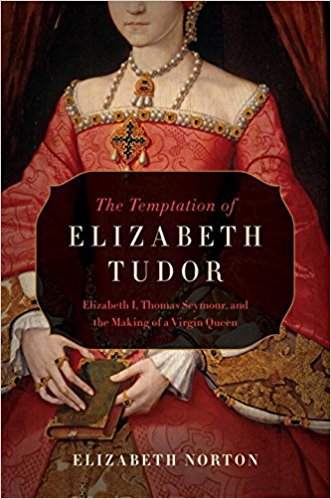
A power-hungry and charming courtier. An impressionable and trusting princess. The Tudor court in the wake of Henry VIII’s death had never been more perilous for the young Elizabeth, where rumors had the power to determine her fate
England, late 1547. King Henry VIII Is dead. His fourteen-year-old daughter Elizabeth is living with the king’s widow, Catherine Parr, and her new husband, Thomas Seymour. Seymour is the brother of Henry VIII’s third wife, the late Jane Seymour, who was the mother to the now-ailing boy King.
Ambitious and dangerous, Seymour begins and overt flirtation with Elizabeth that ends with Catherine sending her away. When Catherine dies a year later and Seymour is arrested for treason soon after, a scandal explodes. Alone and in dreadful danger, Elizabeth is threatened by supporters of her half-sister, Mary, who wishes to see England return to Catholicism. She is also closely questioned by the king’s regency council due to her place in the line of succession. Was she still a virgin? Was there a child? Had she promised to marry Seymour?
Under pressure, Elizabeth shows the shrewdness and spirit she would later be famous for. She survives the scandal, but Thomas Seymour is not so lucky. The “Seymour Scandal” led Elizabeth and her advisers to create of the persona of the Virgin Queen.
On hearing of Seymour’s beheading, Elizabeth observed, “This day died a man of much wit, and very little judgment.” His fate remained with her. She would never allow her heart to rule her head again.
cover and blurb via amazon
~~
While Edward Seymour, the eldest brother of Jane, Queen of England, was well-connected, respected, and Lord Protector of King Edward VI, there was the just as well-known brother, Thomas. Thomas Seymour had his own interesting, but definitely not as prestigious, history. Seymour was the brother of one of the Henry’s queens, and uncle to the young King Edward. Because of this happy accident, Seymour had a high sense of importance, and felt he was owed a place close to the young king and parliament.
Seymour wandered his way through the latter part of Henry’s reign (after the death of Jane) and was madly in love with Catherine Parr. When her second husband died, Seymour and Parr were keen to marry; but King Henry decided he needed a sixth wife and took Catherine for himself.
Seymour had previously tried to get himself a bride in the form of Henry’s daughter, Princess Mary, without success. When Henry dropped dead, Thomas’ paramour was no longer a queen, and Seymour married Parr just four months after Henry was buried. With Edward Seymour the child king’s Protector, Seymour was now married to the king’s stepmother, and got himself the title of Lord High Admiral.
That was when the self-entitled younger brother started to show off his creepy in a more obvious way. Before the hurried marriage to Catherine, Seymour had asked to marry 13-year-old Elizabeth, without success. Now, married to the dowager queen, Seymour had access to little Elizabeth every single day.
June 1547 was only months after her father’s death, and Elizabeth started receiving early morning visits from Seymour, coming into her room half-dressed while she was in her nightgown, even once climbed into her bed, and was known to smack her butt when given the chance. She was only 13, he was married and beneath her, and for a man to do such things in a girl’s rooms was considered shameful. Poor Elizabeth had no say, and Catherine soon started to be suspicious. With Catherine pregnant, Seymour would have had a wandering eye – and it seems all he ever wanted was little Elizabeth, and more importantly, the power she held.
By mid 1548, things were out of hand and Catherine found her husband with Elizabeth in his arms, and Elizabeth was banished. Sent away, Elizabeth spent months sick after the acts – some whispered pregnancy, though more likely shock of the abuse and then banishment.
Poor Catherine Parr died a week after giving birth to a daughter, in September 1548. Seymour sent a nephew to Elizabeth’s new household to spy on her, and asked whether or not her butt had grown any since he had last grabbed it. Talk about a pervert.
Luckily for Elizabeth, she did not have to suffer Seymour’s abuse again, and in January 1549, Seymour got arrested for conspiring to marry Elizabeth, kidnap Elizabeth’s brother, the King Edward, and rule England himself. Elizabeth testified against Seymour, as did two servants to Elizabeth, and Seymour was beheaded in March 1549.
Given the lack of evidence, the abuse suffered by Elizabeth is questioned, sometimes written off as play or harmless games. This book is a great read for anyone who wants to know more about these years of Elizabeth’s early life. To me, Seymour comes across as a classic abuser; makes a girl feel shamed and claims all is in jest, which mocks the victim further. Catherine Parr knew something was happening, and didn’t scorn her stepdaughter, but never lived long enough to speak out.
I enjoyed reading this book, and the author did not try to lean the reader in either direction in terms of outcome, but I certainly got my own conclusion on the ugly subject. It could be easy to call this gossip or scandal, when it seems more like an ugly situation many girls and women find themselves in, with few who believe them.
Advertisements Share the love:





